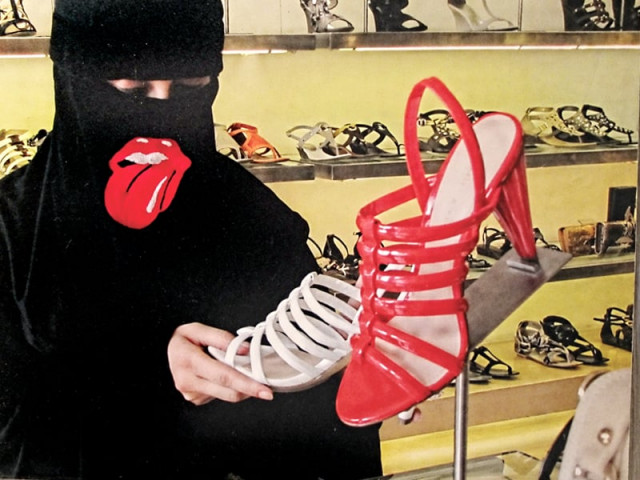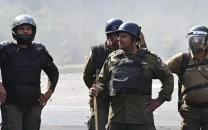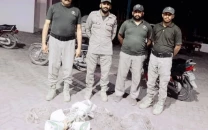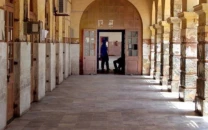With Honors: ‘Dark, demented and grotesque’
9 artists show their work in NCA’s Degree Show.

With Honors: ‘Dark, demented and grotesque’
“People keep saying, ‘so your work is about the Taliban’. But the images are just of a burqa-clad woman roaming around town,” said Amra Khan, speaking about the stereotypes that spring to the viewer’s mind when faced with her photographs and video. “The liberals and the burqa clad women are really very similar. Their consumerism is much the same,” she added.
Khan is one of the nine artists at the National College of Arts MA (Hons) Visual Art degree show. The show is mostly in the Zahoorul Ikhlaq Gallery, Iranian born artist Esmaeil Arbab’s steel and metal sculptures are in the lawn. Arbab got his bachelors in handicrafts and came to NCA for his master’s degree. “The four elements of art, as afar as I am concerned, is the idea, materials, form and colour,” Arbab said.
Maira Khan’s work stems from ‘a mixed batch of memories, some pleasant and some not so much’. “My work surprises me, it reminds me of things I had forgotten,” she said. Maira, speaking about her work, Robin, said she found herself imbuing her subject with her own hair, characteristics and clothes as she painted them. “I entered this programme because I just wanted to work. And that’s really my plan for the future. I just want to work all day, draw and paint.”
Sarah Ahmed Mumtaz’s performance piece was set in a personal space which she said ‘was filled with emotions’. Mumtaz listed her inspiration as octopus babies and Tim Burton’s poem ‘The pin cushion queen’. Her work uses embroidery and prints (she had graduated as a print maker). Mumtaz’s performance did not shy away from her physical disability.
“I was reading a history of weaving and found that most artisans’ tribes had a power motif. I thought about what that would be for us as a nation and settled on the flag,” said Imrana Tanveer. She said one of her works, which had chappals lying on the US flag, had been met with a mixed response. “Some people were so happy as they saw this as an insult to the US, while my jury asked me if I would show this particular piece when I apply for a Fulbright scholarship. I am not ashamed of any of my work.”
Tanveer said the work was more complicated then perceived. “We might be frustrated with the US and take out our aggression by burning their flag but we are equally responsible for the situation we are in. What does it say about us as a nation when we burn their flag. At least they welcome criticism. Do we?” she said.
Another work was a collection of Pakistani flags. “Each flag is slightly different, with symbols of political, economic or social significance. The surface might be embellished but when you go closer you will notice different things,” the artist said.
Rabiya Asim joined the mater’s programme to ‘refine’ her intellect and get more of a theoretical base for her work. “My work questions reality and illusion. I use mirrors to comprehend the truth.” Asim lists Bill Viola as an influence. Speaking about her installation piece, Enclosure of Sanctity, the artist said her work was interactive.
“My daughter is central to my work. I know I keep bringing her up but when she would play with her dolls, feed them and also reject them, I saw that as a great way to represent the joy and pain in humankind,” said Mizna Zulfiqar. Zulfiqar said that most of her stuffed dolls were feminine, ‘I think that might be because I am a woman,’ she laughed. “I felt so guilty when my students would ask me questions. I was stuck and needed to move forward,” she said explaining her motive to join the master’s programme.
Mohsin Shafi’s 26 pictrue frames are laid out on a 26 foot console. “The idea was to create confusion for the viewer. This work is a process, it’s not final, it keeps growing,” he said. Shafi’s collages are mixed media and he added that the personal and the political had comingled for him in these pieces.
Irfan Gul decided to pursue a mater’s degree as he felt he needed academic input in his work. “I have moved away from acrylic pigment and dry ink to digital prints on which I doodle and draw,” Gul said. He added that his work dealt with doubts and fears in his family and draws on early childhood experiences.
“I was a textile designer. They would give me designs to copy. It was stifling. I wanted to explore my creativity again and joined this programme,” added Tanveer.
“I like people located in the centre. I want the viewer to have more to think about,” said Amra Khan explaining the androgynous figures that habituate her paintings. “When Maira, Mizna and I put up our work in the front gallery, we realised it looked dark, demented and grotesque. That was not what we were aiming for.” Khan said her paintings contained narratives one doesn’t ordinarily share with others. She also had used photographs and video to examine stereotypes. The show closes on January 11.
Published in The Express Tribune, January 10th, 2012.



















COMMENTS
Comments are moderated and generally will be posted if they are on-topic and not abusive.
For more information, please see our Comments FAQ